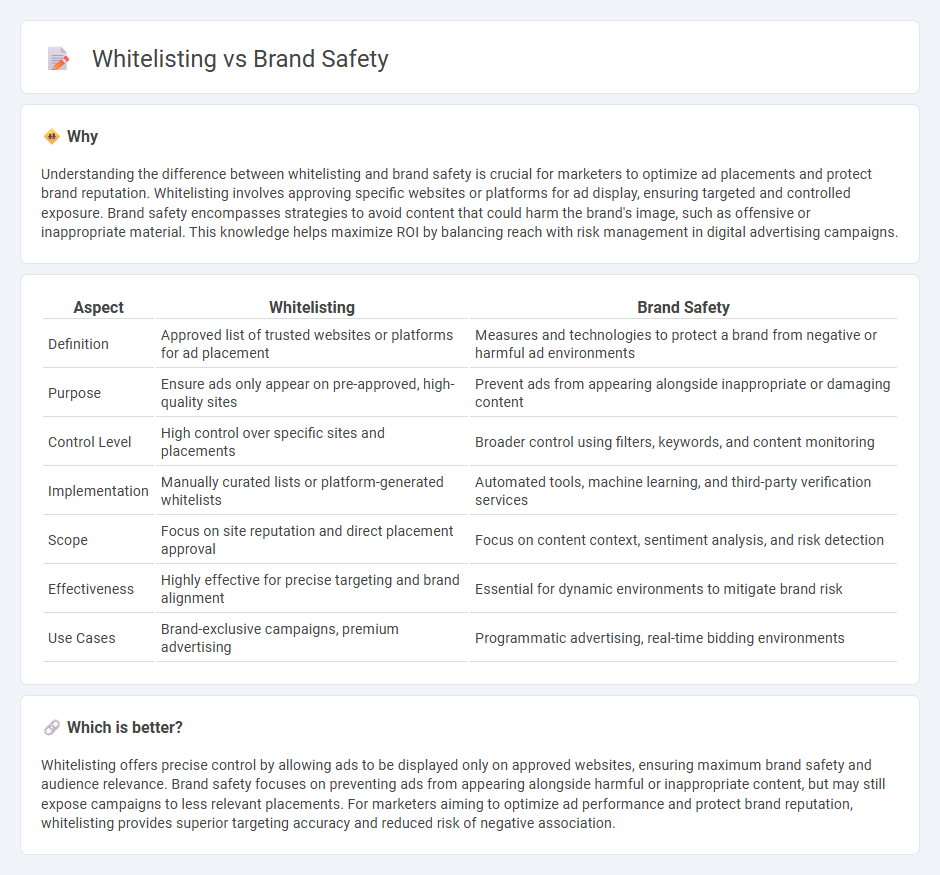
Whitelisting in marketing involves pre-approving specific websites or apps where ads are allowed to appear, ensuring targeted exposure and reducing the risk of brand misplacement. Brand safety encompasses strategies and technologies designed to protect a brand's reputation by preventing ads from appearing alongside harmful or inappropriate content. Explore the differences between whitelisting and brand safety to enhance your advertising strategy effectively.
Why it is important
Understanding the difference between whitelisting and brand safety is crucial for marketers to optimize ad placements and protect brand reputation. Whitelisting involves approving specific websites or platforms for ad display, ensuring targeted and controlled exposure. Brand safety encompasses strategies to avoid content that could harm the brand's image, such as offensive or inappropriate material. This knowledge helps maximize ROI by balancing reach with risk management in digital advertising campaigns.
Comparison Table
| Aspect | Whitelisting | Brand Safety |
|---|---|---|
| Definition | Approved list of trusted websites or platforms for ad placement | Measures and technologies to protect a brand from negative or harmful ad environments |
| Purpose | Ensure ads only appear on pre-approved, high-quality sites | Prevent ads from appearing alongside inappropriate or damaging content |
| Control Level | High control over specific sites and placements | Broader control using filters, keywords, and content monitoring |
| Implementation | Manually curated lists or platform-generated whitelists | Automated tools, machine learning, and third-party verification services |
| Scope | Focus on site reputation and direct placement approval | Focus on content context, sentiment analysis, and risk detection |
| Effectiveness | Highly effective for precise targeting and brand alignment | Essential for dynamic environments to mitigate brand risk |
| Use Cases | Brand-exclusive campaigns, premium advertising | Programmatic advertising, real-time bidding environments |
Which is better?
Whitelisting offers precise control by allowing ads to be displayed only on approved websites, ensuring maximum brand safety and audience relevance. Brand safety focuses on preventing ads from appearing alongside harmful or inappropriate content, but may still expose campaigns to less relevant placements. For marketers aiming to optimize ad performance and protect brand reputation, whitelisting provides superior targeting accuracy and reduced risk of negative association.
Connection
Whitelisting and brand safety are interconnected through their shared goal of protecting a brand's reputation by restricting advertising placements to pre-approved, trustworthy websites. Whitelisting ensures ads appear only on vetted platforms that align with brand values, significantly reducing the risk of negative associations or fraudulent traffic. This controlled approach enhances campaign effectiveness while safeguarding against harmful content and preserving consumer trust.
Key Terms
Ad Placement
Brand safety ensures advertisements avoid harmful or inappropriate content, maintaining a positive association with the brand, while whitelisting restricts ad placement to pre-approved, high-quality websites or channels. Both strategies prioritize effective ad placement but differ in scope: brand safety uses algorithms and contextual analysis to exclude risks, whereas whitelisting proactively selects trusted platforms to guarantee brand alignment. Explore deeper insights on optimizing ad placements for maximum brand protection and performance.
Content Filtering
Brand safety relies on content filtering to prevent ads from appearing alongside harmful or inappropriate content, using machine learning algorithms and keyword blocking for precision. Whitelisting involves pre-approved site or content lists, ensuring ads only run on trusted platforms aligned with brand values. Explore more about optimizing brand safety strategies through effective content filtering and whitelisting techniques.
Approved Inventory
Brand safety ensures advertisements appear in suitable and secure environments, mitigating risks associated with fraudulent or harmful content. Whitelisting targets approved inventory by pre-selecting specific websites or channels deemed safe, enhancing control over ad placements. Explore how approved inventory strategies optimize brand protection and ad performance effectively.
Source and External Links
What Is Brand Safety? (Definition, Examples, And Best Practices) - Brand safety is the practice of protecting a brand's reputation by preventing its ads from appearing in unsafe or inappropriate online environments, such as next to harmful, controversial, or misleading content.
Brand safety - Brand safety involves measures to shield brands from negative associations by avoiding ad placements next to questionable content, including categories like violence, hate speech, and fake news, often using tools like blacklists, whitelists, and third-party verification services.
Brand Safety - Brand safety uses technology and practices to block ads from appearing alongside harmful or inappropriate content, ensuring campaigns align with brand values and audience expectations for maximum safety and positive impact.
 dowidth.com
dowidth.com